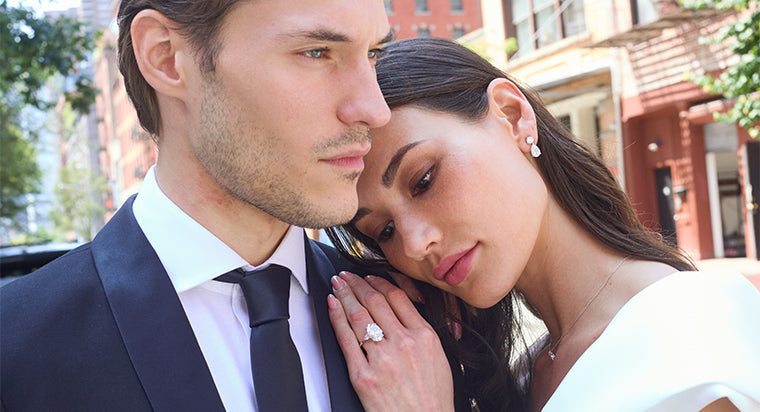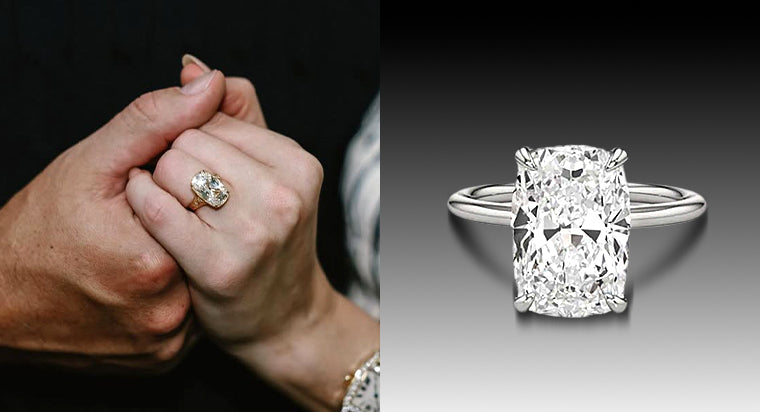Everything You Need to Know About the History of Wedding Bands

Have you ever stopped to think about where the tradition of exchanging wedding bands began? The history of wedding bands is an interesting one that dates back thousands of years. It's always been a symbol of love and commitment, but the meaning behind rings has varied among cultures and at different times. Some cultures viewed rings as a legal contract, while others exchanged rings only for love. In this article, we'll explore wedding bands throughout history and look at rings today.
TABLE OF CONTENTS
Historical Origins
The earliest wedding bands can be traced back to ancient Egypt about 5,000 years ago. Early rings used braided hemp, leather, reeds, or bone, according to the Gemological Society of America (GIA). Early Roman engagement rings were made of ivory, flint, bone, copper, or iron and worn to show mutual love and obedience.
Egyptian Pharaohs first used rings to represent eternity. The circle shape matches the shape of the sun and the moon, which is important in their culture, and they value that circles don't have a beginning or an end. Archeologists discovered gold rings and jewelry in the Pompeii ruins, so eventually, gold replaced earlier jewelry materials.
Ancient Romans introduced the tradition of betrothal rings. They were given two rings - one made of iron and the other made of gold, according to the GIA. The iron ring was worn indoors, and the gold version was worn outdoors. Rome is well known for their clasped hands motif (called the fede motif), which represents the holding of hands during a wedding ceremony and a promise of marriage.
Cultural Variations
Some cultures have their own customs regarding wedding bands - the idea of wearing the wedding band on the left-hand dates back to ancient Egypt. Egyptians used to believe that the fourth finger on the left hand contained a "vein of love" that led to the heart. For example, the ring is worn on the left hand in most countries where English is spoken, while people in many Orthodox Christian and Eastern European cultures wear their wedding ring on the right. Some cultures believed rings were legal contracts between husband and wife, while others gave thimbles instead of rings.
Medieval and Renaissance Period
During medieval times, Europeans began giving engagement rings with gemstones. Medieval Europeans used sapphires to symbolize the heavens, rubies to symbolize passion, and diamonds to symbolize steadfast strength, according to the GIA. It was also common for couples of this time period to exchange "posy rings" that were inscribed with romantic poetry or religious verses. Some rings also feature religious motifs, such as crosses. A well-known medieval ring is called the Gimmel ring. It features two or three interlocking bands that symbolize unity and fidelity. It's said that each couple wore a single ring, and during the marriage ceremony, the two rings would become one that the bride would wear.
Archduke Maximillian of Austria in 1477 commissioned the first documented diamond engagement ring for his betrothed, Mary of Burgundy, according to the American Gem Society. The Archduke started a trend for diamond rings among European aristocracy and nobility. During the Renaissance period, diamond engagement rings became more popular, and the designs became more creative. Settings featured more elaborate and ornate designs as well as multiple stones.
Modernization and Changes
Wedding bands have evolved over time. While they started off as simple gold bands, today, you can find wedding bands made from various metals. Styles for men and women have expanded as well. Some are simpler, while others are more elaborate with diamonds, gemstones, and a mixture of both. Whether for her, him, or they, you can find the perfect wedding ring that represents you with the amount of available options. Varying gender roles and same-sex marriages have also impacted the need for a variety of styles. We at With Clarity have a range of modern wedding bands perfect for modern couples.
Symbolism
The meaning behind a circular wedding band is that it's never-ending and doesn't have a beginning or an end. It symbolized eternal love and everlasting commitment. Diamonds are commonly used in wedding bands because they're rare and strong, like the loving bond between a husband and a wife.
Customization and Personalization
You can customize rings today in a variety of ways. Beyond choosing the setting, you can choose the metals and the stones within the setting to create your perfect ring. You can also engrave a custom message inside the wedding band–think quotes, dates, secret messages, song lyrics, etc. At With Clarity, you pick if you want a metal or a diamond wedding band; you can also choose between a lab grown diamond or a natural diamond to create a ring that represents you.
Traditional vs. Modern Trends
Wedding bands in the past were simpler, and while simple wedding rings are still popular today, you'll also find rings that are more ornate. Antique wedding bands are also more popular. And for those who want a ring with a vintage look, you'll find plenty of wedding bands with a vintage style. At With Clarity, you will find a range of traditional or modern wedding bands to choose from for your dream wedding.
Famous Wedding Bands in History
You might know about a couple's notable wedding bands from the past. Queen Victoria's wedding ring was unconventional at the time. Her ring was shaped like a serpent that wrapped around the finger, and the ring included small rubies, diamonds, and an emerald, which was Queen Victoria's birthstone.
Recent Innovations
Technological advancements, like the use of 3D printing, have allowed jewelers to bring a sketch of a wedding band to life. With Clarity uses 3D technology to create replicas of custom-designed rings so people can try on a few rings that they're considering to see which one works best. Another innovative idea that is impacting jewelry is the growing popularity and incredible quality of lab grown diamonds. Lab technologies continue to get better and better.
Conclusion
Wedding bands symbolize infinite love and eternal commitment to one another because a circle is continuous and doesn't have a beginning or an end. Rings have evolved from simple leather bands to elaborate bands decorated with diamonds. Today's wedding bands can be customized–especially if you purchase your band from With Clarity. Select the design, metal, and total carat weight and create a ring that's perfect for you and unique.









